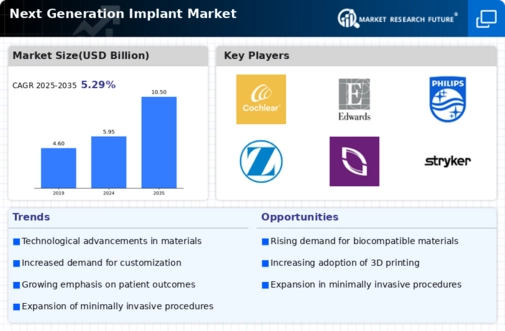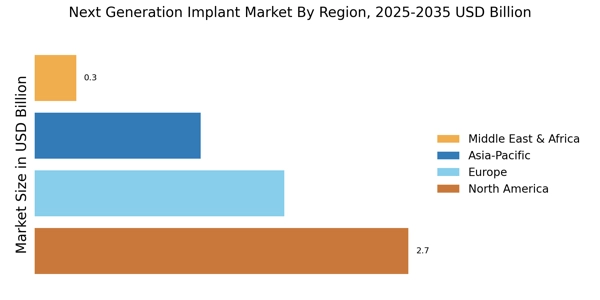Aging Population
The aging population is a critical factor influencing the Next Generation Implant Market. As life expectancy increases, the demand for medical implants, particularly in orthopedics and cardiology, is expected to rise significantly. By 2030, it is estimated that nearly 1 in 6 individuals will be aged 65 and older, leading to a surge in age-related health issues that require surgical interventions. This demographic shift is likely to drive the demand for advanced implant technologies that cater to the unique needs of older patients. Furthermore, the market is witnessing a trend towards minimally invasive procedures, which are particularly appealing to the elderly population. This shift not only enhances recovery times but also aligns with the growing preference for patient-centric healthcare solutions.
Technological Advancements
The Next Generation Implant Market is experiencing a surge in technological advancements that enhance the functionality and effectiveness of implants. Innovations such as 3D printing and advanced imaging techniques are revolutionizing the design and manufacturing processes. For instance, 3D printing allows for the creation of customized implants tailored to individual patient anatomies, which may lead to improved surgical outcomes. Furthermore, the integration of smart technologies, such as sensors and wireless communication, enables real-time monitoring of implant performance. This trend is expected to drive market growth, as the demand for more efficient and effective implant solutions continues to rise. The market is projected to reach a valuation of approximately 50 billion dollars by 2026, indicating a robust growth trajectory fueled by these technological advancements.
Rising Incidence of Chronic Diseases
The prevalence of chronic diseases is a significant driver for the Next Generation Implant Market. Conditions such as diabetes, cardiovascular diseases, and orthopedic disorders are on the rise, necessitating advanced implant solutions for effective management. According to recent statistics, the incidence of diabetes alone is expected to increase by 50% by 2030, leading to a higher demand for implants like insulin pumps and orthopedic devices. This growing patient population is likely to propel the market forward, as healthcare providers seek innovative implant technologies to improve patient outcomes. The increasing burden of chronic diseases underscores the need for next-generation implants that offer enhanced functionality and better integration with existing healthcare systems.
Increased Investment in Healthcare Infrastructure
Investment in healthcare infrastructure is a pivotal driver for the Next Generation Implant Market. Governments and private entities are increasingly allocating resources to enhance healthcare facilities and technologies, which directly impacts the availability and adoption of advanced implant solutions. For instance, initiatives aimed at modernizing hospitals and clinics are likely to facilitate the integration of next-generation implants into routine medical practice. Additionally, funding for research and development in implant technologies is on the rise, fostering innovation and improving product offerings. This trend is expected to create a favorable environment for market growth, as enhanced healthcare infrastructure supports the deployment of cutting-edge implant solutions that meet evolving patient needs.
Growing Awareness and Acceptance of Implant Technologies
The growing awareness and acceptance of implant technologies among patients and healthcare providers is a significant driver for the Next Generation Implant Market. Educational campaigns and increased access to information have led to a better understanding of the benefits associated with advanced implants. Patients are becoming more informed about their treatment options, which may lead to higher acceptance rates for surgical interventions involving implants. Moreover, healthcare professionals are increasingly recognizing the advantages of next-generation implants, such as improved biocompatibility and functionality. This shift in perception is likely to drive demand, as more patients opt for innovative implant solutions that promise enhanced quality of life and better health outcomes.


















Leave a Comment